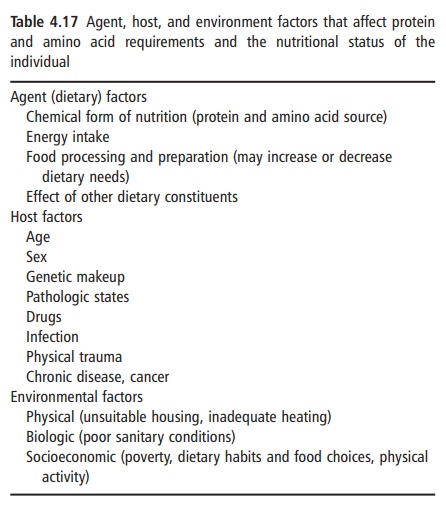Chapter: Introduction to Human Nutrition: Nutrition and Metabolism of Proteins and Amino Acids
Factors other than diet affecting protein and amino acid requirements
Factors other than diet affecting
protein and amino acid requirements
Not everyone of the same age, body build, and gender has the
same nutrient requirements. These differences may be due, in part, to
variations in genetic back- ground. Various environmental, physiological,
psy-chological, and pathological influences affect the vari-ability in
physiological requirements for nutrients among individuals (Table 4.17). For
example, as already discussed, the growing infant or child requires higher
nutrient intakes per unit of body weight than does the adult. Besides energy,
for which the daily requirement declines with age because of reduced physical
activity, it appears that the nutrient needs of healthy aged subjects do not
differ significantly from those of young adults. Nevertheless, a characteristic
of aging is an increased incidence of disease and mor-bidity, which is likely
to be far more important than age per se in determining practical differences
between the nutrient requirements of younger adults and elderly people.

Thus, superimposed infection, altered gastro-intestinal
function, and metabolic changes that often accompany chronic disease states
would all be expected to reduce the efficiency of dietary nitrogen and amino
acid utilization. The metabolic response to acute infection in healthy young
men has been characterized in experiments involving different types of
intracellular infection, and involves an increased loss of body nitrogen,
together with increased losses of several other nutrients including potassium,
mag-nesium, phosphorus, and vitamin C. This increased loss clearly implies
increased needs for nitrogen, amino acids, and other nutrients.
In addition to the catabolic response of body nitro-gen
metabolism to infection and trauma, there is a corresponding anabolic component
that is of major importance during recovery from these stressful con-ditions.
Anabolic responses occur not only during recovery but also in the early phase
of illness, when anabolism is associated with increased production of
immunocompetent cells such as phagocytes and other leukocytes, and the
induction of several tissue enzymes and immunoglobulins.
During recovery from infection two characteristics of the
anabolic period that follows are that the increased nitrogen retention seen
during this period is greater than that measured during the preincubation
phase, and its duration is much longer than the catabolic period. This may be
due, in part, to the effect of protein depletion antedating an acute episode,
which may be the case in poor communities. However, in spite of the potential
for disease states to increase protein and amino acid needs there are too few
studies that help to assess precisely their quantita-tive influence on nutrient
utilization and dietary requirements.
Related Topics